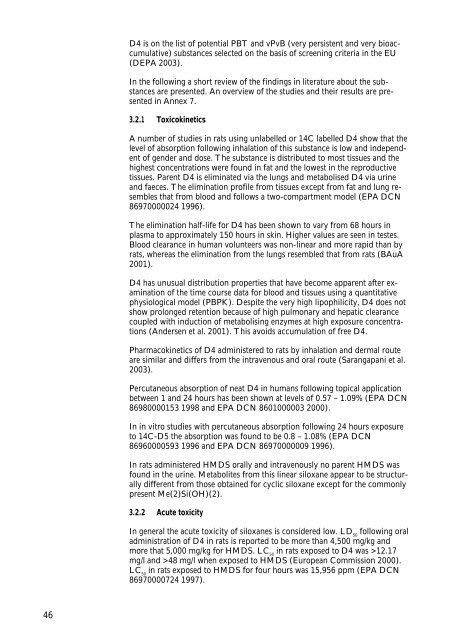No. 1031 - Miljøstyrelsen
No. 1031 - Miljøstyrelsen
No. 1031 - Miljøstyrelsen
You also want an ePaper? Increase the reach of your titles
YUMPU automatically turns print PDFs into web optimized ePapers that Google loves.
46<br />
D4 is on the list of potential PBT and vPvB (very persistent and very bioaccumulative)<br />
substances selected on the basis of screening criteria in the EU<br />
(DEPA 2003).<br />
In the following a short review of the findings in literature about the substances<br />
are presented. An overview of the studies and their results are presented<br />
in Annex 7.<br />
3.2.1 Toxicokinetics<br />
A number of studies in rats using unlabelled or 14C labelled D4 show that the<br />
level of absorption following inhalation of this substance is low and independent<br />
of gender and dose. The substance is distributed to most tissues and the<br />
highest concentrations were found in fat and the lowest in the reproductive<br />
tissues. Parent D4 is eliminated via the lungs and metabolised D4 via urine<br />
and faeces. The elimination profile from tissues except from fat and lung resembles<br />
that from blood and follows a two-compartment model (EPA DCN<br />
86970000024 1996).<br />
The elimination half-life for D4 has been shown to vary from 68 hours in<br />
plasma to approximately 150 hours in skin. Higher values are seen in testes.<br />
Blood clearance in human volunteers was non-linear and more rapid than by<br />
rats, whereas the elimination from the lungs resembled that from rats (BAuA<br />
2001).<br />
D4 has unusual distribution properties that have become apparent after examination<br />
of the time course data for blood and tissues using a quantitative<br />
physiological model (PBPK). Despite the very high lipophilicity, D4 does not<br />
show prolonged retention because of high pulmonary and hepatic clearance<br />
coupled with induction of metabolising enzymes at high exposure concentrations<br />
(Andersen et al. 2001). This avoids accumulation of free D4.<br />
Pharmacokinetics of D4 administered to rats by inhalation and dermal route<br />
are similar and differs from the intravenous and oral route (Sarangapani et al.<br />
2003).<br />
Percutaneous absorption of neat D4 in humans following topical application<br />
between 1 and 24 hours has been shown at levels of 0.57 – 1.09% (EPA DCN<br />
86980000153 1998 and EPA DCN 8601000003 2000).<br />
In in vitro studies with percutaneous absorption following 24 hours exposure<br />
to 14C-D5 the absorption was found to be 0.8 – 1.08% (EPA DCN<br />
86960000593 1996 and EPA DCN 86970000009 1996).<br />
In rats administered HMDS orally and intravenously no parent HMDS was<br />
found in the urine. Metabolites from this linear siloxane appear to be structurally<br />
different from those obtained for cyclic siloxane except for the commonly<br />
present Me(2)Si(OH)(2).<br />
3.2.2 Acute toxicity<br />
In general the acute toxicity of siloxanes is considered low. LD 50 following oral<br />
administration of D4 in rats is reported to be more than 4,500 mg/kg and<br />
more that 5,000 mg/kg for HMDS. LC 50 in rats exposed to D4 was >12.17<br />
mg/l and >48 mg/l when exposed to HMDS (European Commission 2000).<br />
LC 50 in rats exposed to HMDS for four hours was 15,956 ppm (EPA DCN<br />
86970000724 1997).

















